For beginning and more advanced foragers alike, it’s important to have some guidebooks on hand. I often get asked what my favorite foraging books are, and there are so many good ones to choose from! I’ve narrowed it down to what I think are the 12 best books about foraging and wildcrafting for you here. These books will give you a great start on how to find, identify, harvest, and use wild plants!
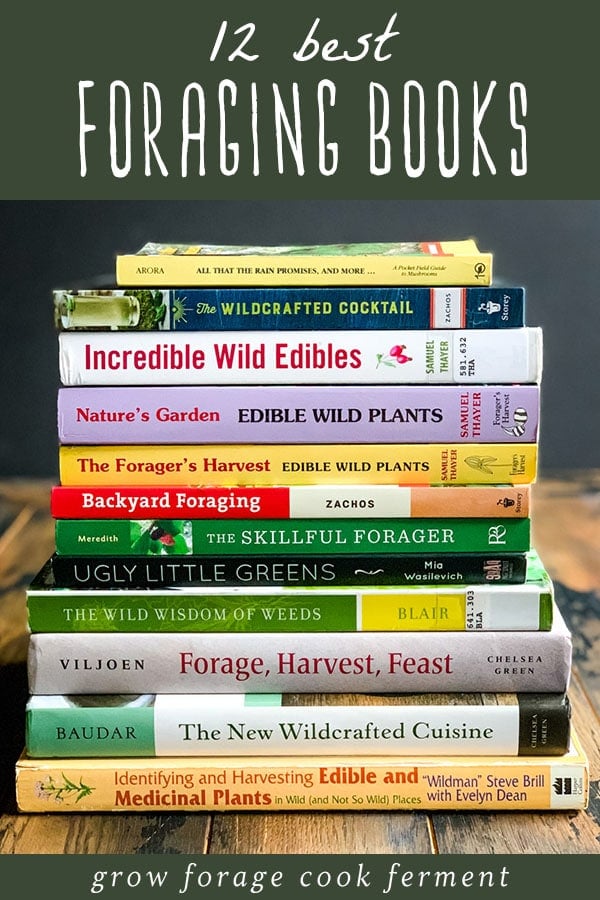
Want to save this post for later?
Wildcrafting Weeds eBook
Before I get to the 12 best foraging books, I want to let you know that I have a foraging eBook and a foraging course!
Wildcrafting Weeds: 20 Easy to Forage Edible and Medicinal Plants teaches beginning foragers how to identify common edible and medicinal plants that might be growing in your backyard. You’ll learn straightforward techniques and recipes to forage and use wild weeds with confidence!
12 Best Foraging & Wildcrafting Books
These are my favorite foraging and wildcrafting books, from identifying edible and medicinal plants and mushrooms to how to cook with and use your foraged finds. I think you will love these books!
I should mention that most of these books are focused primarily on plants that are found in North America.
That said, many common edible and medicinal plants grow worldwide, so these books may still be beneficial to have no matter where you live!
Be sure to check out my other book guides here:
- Best Foraging Books for Kids
- 15 Best Mushroom Books for Kids
- 15 Best Books on Herbalism and Natural Body Care
- 12 Best Books on Fermenting and Homebrewing
- 12 Best Permaculture Books for Garden Planning
Related: Gift Guide for Foragers and Wildcrafters
Identifying and Harvesting Edible and Medicinal Plants
One of the most comprehensive foraging books out there is Identifying and Harvesting Edible and Medicinal Plants in Wild (and Not So Wild) Places by “Wildman” Steve Brill and Evelyn Dean.
This is one of my favorite resources for a few reasons. It covers a large number of plants, includes medicinal plants, and is organized by the seasons.
While it may be hard for some people to get used to, I actually love the fact that it’s organized by the seasons. I think this is so helpful for knowing when to find things!
The only potential downfall to this book is the fact that it uses drawings instead of actual photos of the plants. The drawings are really good, so it doesn’t bother me too much, but it is often helpful to see a real color photo of the plant.
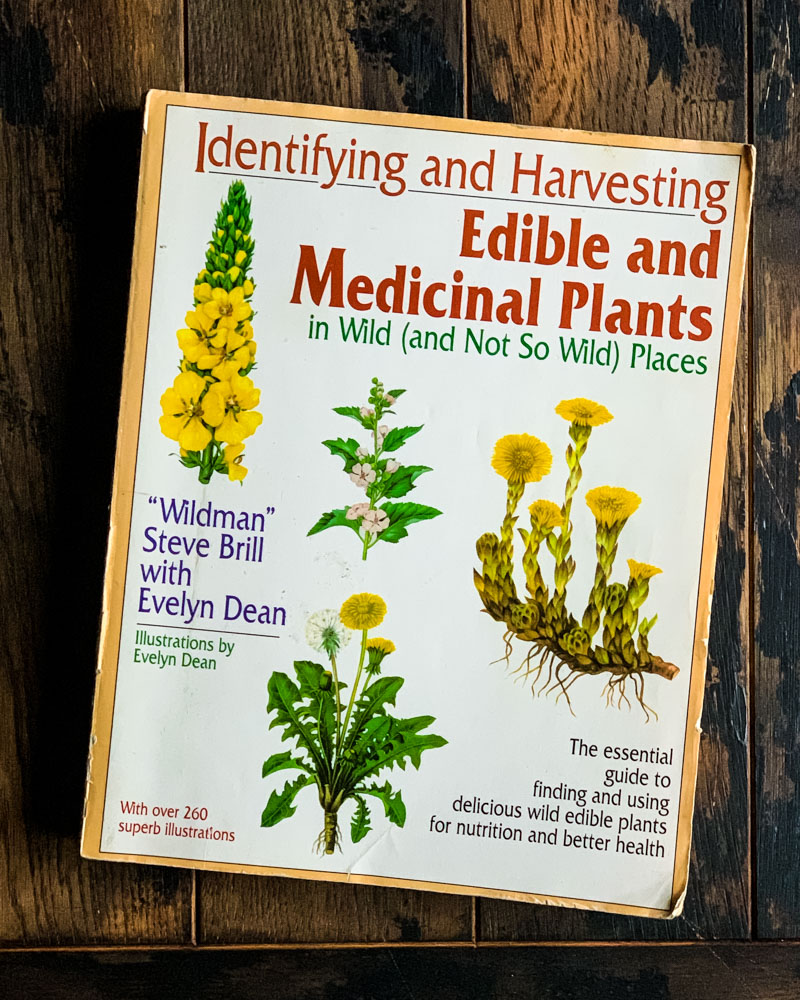
The Forager’s Harvest, Nature’s Garden, and Incredible Wild Edibles
These three amazing books are all by Samuel Thayer:
I love them because they all have amazing photos and the identification information is top notch. Each book covers around 30-40 plants, so if you have all three that gives you information for over 100 plants.
His first book, The Forager’s Harvest, is geared slightly more towards plants in the eastern half of the United States and Canada, but I still find it useful being in the west. The other two books cover more widespread plants throughout North America.
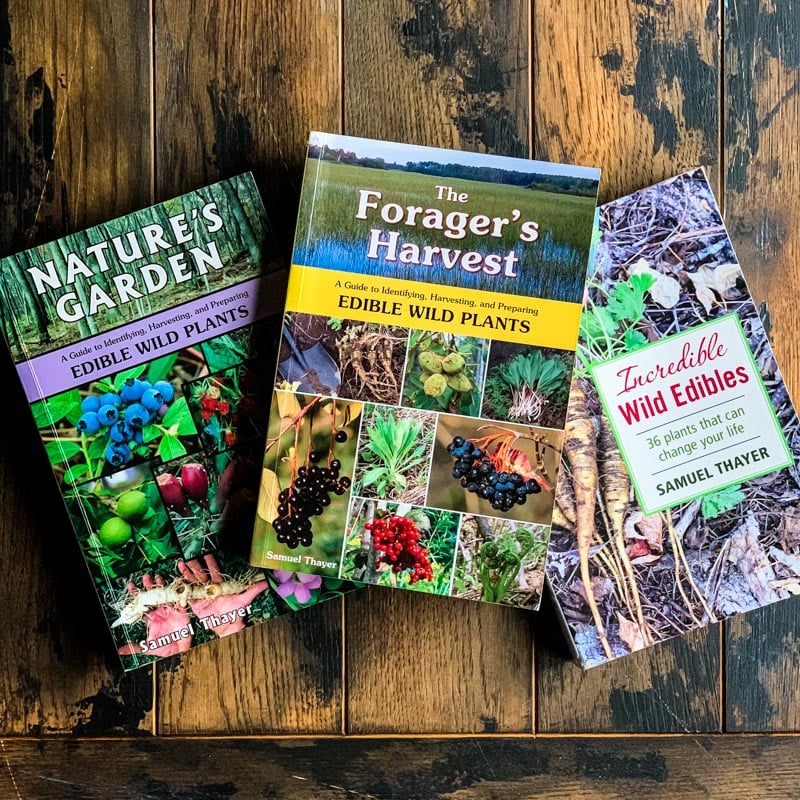
The Skillful Forager
I love The Skillful Forager by Leda Meredith because it is geared towards more intermediate to advanced foragers. That said, I would still recommend it for beginning foragers, because it has some important concepts in it.
Leda discusses ethical and responsible foraging and harvesting, which is something to be mindful of. She also has plenty of ideas and recipes for how to use your foraged items.
It is not really an identification book per se, but she discusses plant groups (like roots or flowers) with example species for each group. She also talks about the best way to harvest each group of plants.
Leda also has another great foraging book called The Forager’s Feast which is geared more for beginners.
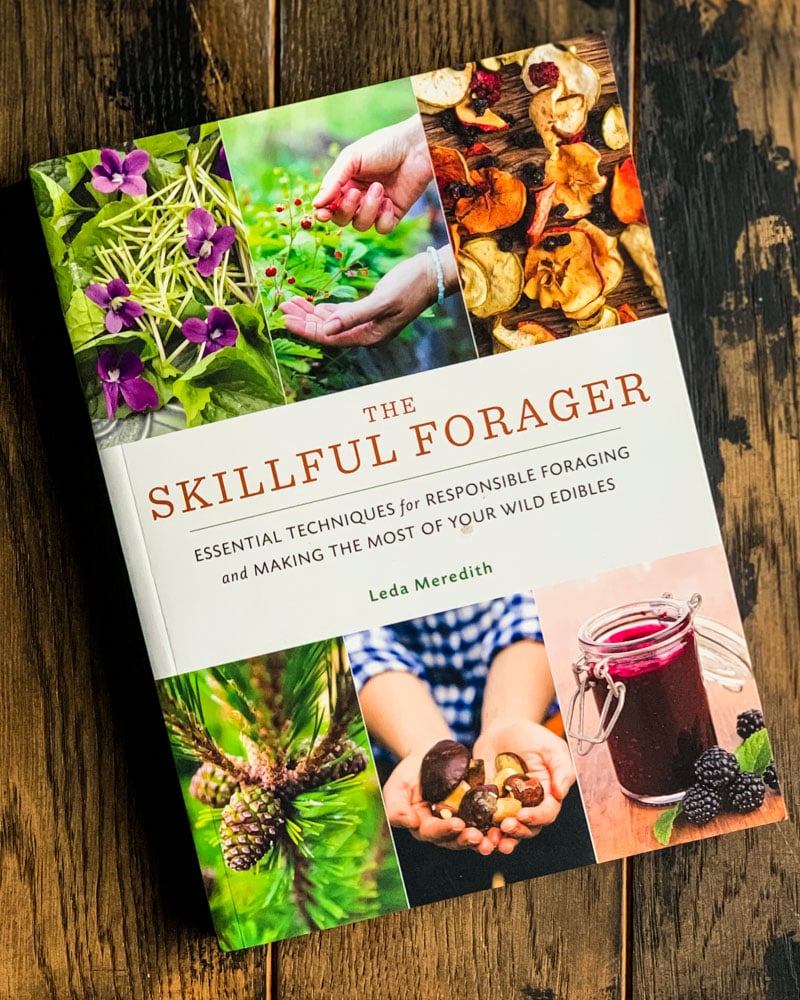
Backyard Foraging and The Wildcrafted Cocktail
Ellen Zachos of the Backyard Forager blog has two foraging books that I just love. She has an easy-to-read writing style that makes you feel like she’s your friend, and she really knows her stuff when it comes to foraging!
Backyard Foraging covers 65 common plants that are probably growing in your backyard or somewhere in your neighborhood. It’s the perfect book for beginning foragers or for those who don’t want to travel far to find tasty edible wild plants.
The Wildcrafted Cocktail is a lovely book that is a must have in any imbibing foragers kitchen. The drink recipes in this book sound so wonderful, made with wild berries, flowers, nuts, roots, trees, and even mushrooms!
Someday I hope to share a wildcrafted cocktail with Ellen!
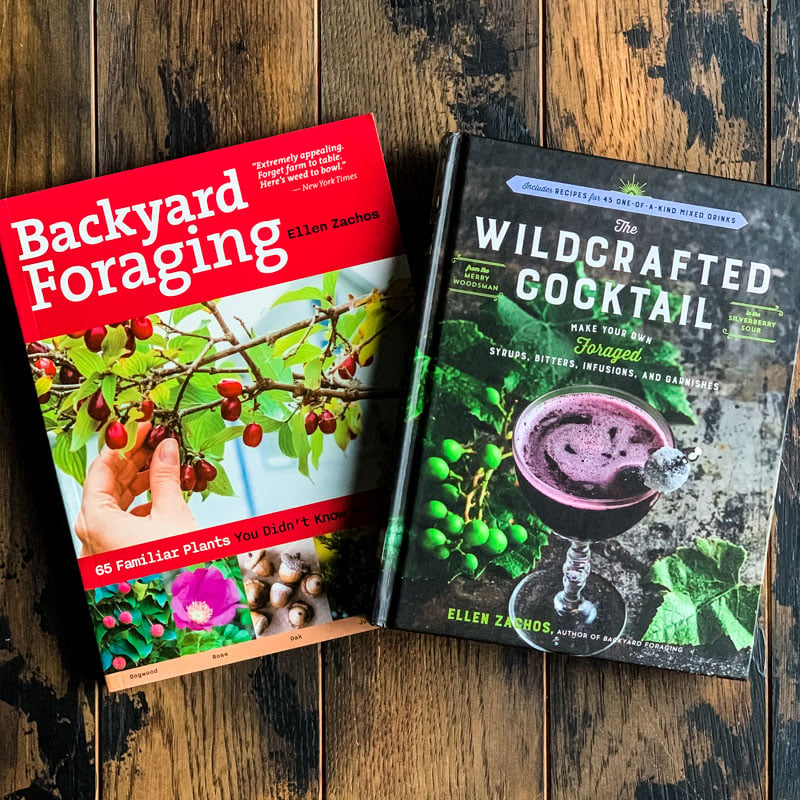
Forage, Harvest, Feast and The Wild Wisdom of Weeds
Here are two wonderful books that include some great wild food recipes.
Forage, Harvest, Feast is a beautiful book by Marie Viljoen of the 66 Square Feet (Plus) blog. It contains over 500 recipes using foraged ingredients such as dandelion, elderflower and elderberry, garlic mustard, and nettles.
The Wild Wisdom of Weeds by Katrina Blair holds a special place in my heart, because I love edible weeds! She covers 13 “weeds,” or essential plants for human survival as she puts it, which is much more accurate. Each plant is discussed in great detail and includes recipes and medicinal uses.
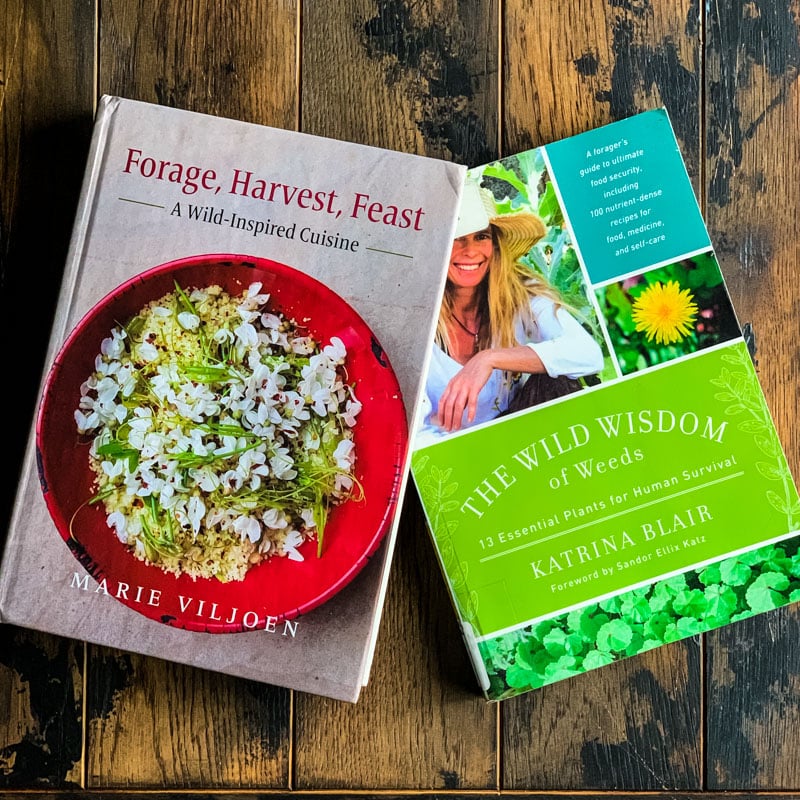
Ugly Little Greens and The New Wildcrafted Cuisine
These two books are for those of you who really like to experiment with wild foods in the kitchen. The recipes included in both books are gourmet works of art!
Ugly Little Greens by gourmet chef Mia Wasilevich has 80 recipes using wildcrafted ingredients that look just divine. She takes simple and easy to find wild plants and turns them into beautiful recipes that anyone would be proud of making!
The New Wildcrafted Cuisine by foraging and fermenting guru Pascal Baudar is not only an amazing resource on local terroir, but is also full of interesting recipes. I’ve made two recipes from this book, wild yeast starter with juniper berries and mugwort lemon beer, and they were both wonderful!
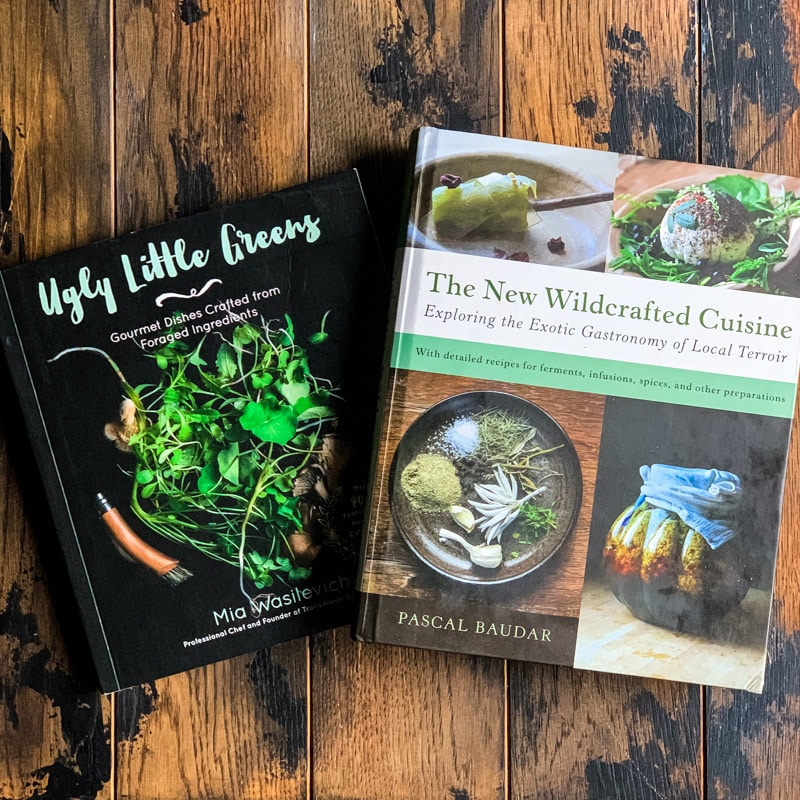
All That the Rain Promises and More
This is hands down my favorite book on foraging mushrooms!
All That the Rain Promises and More by David Arora is a great little mushroom guide. I love it because it has really good photos and descriptions, plus it’s also small enough to take out in the field with you.
Even though it says it’s a guide for western mushrooms, many of the mushrooms included will be found in other regions as well.
It covers the most common edible mushrooms like morels, chanterelles, boletes, chicken of the woods, hedgehogs, and shaggy manes, along with many others. It also covers the most toxic mushrooms, which is equally important!
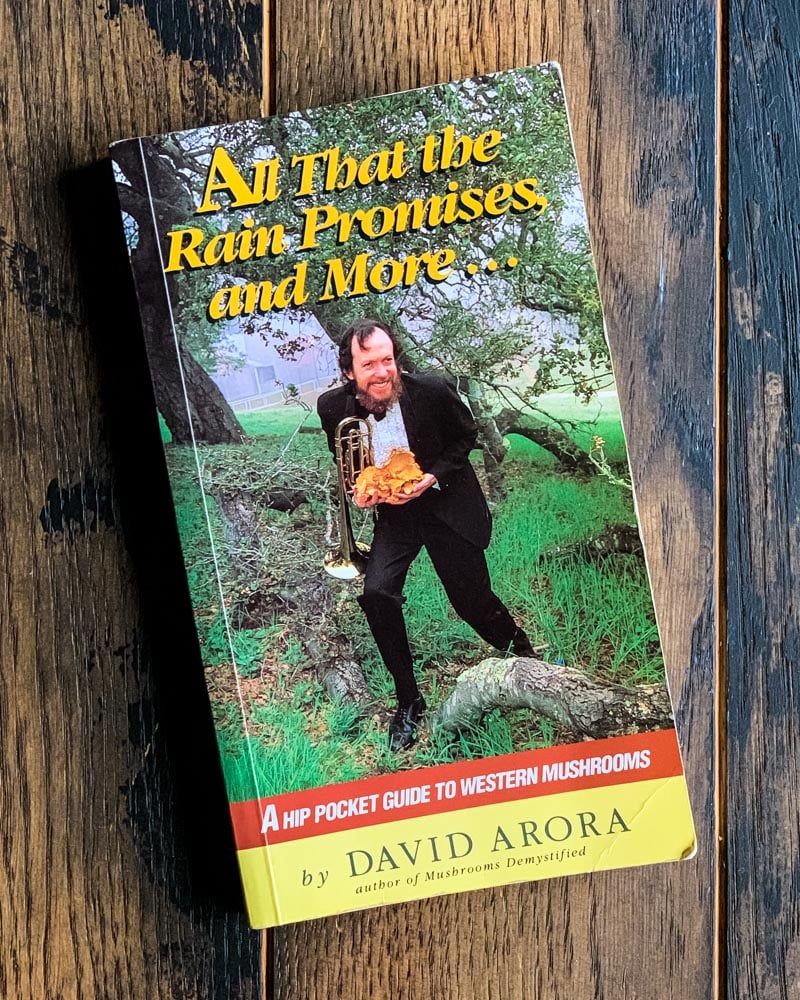
There you have it, the 12 best books on foraging and wildcrafting! These should get you started on your foraging journey. Remember, it’s also a good idea to have a local or regional guide for your area.
Happy foraging!



Ill be getting some of these for my birthday, Im so exited
Wonderful! Enjoy!
THANK YOU SO MUCH! THESE ARE TRULY AMAZING KNOWLEDGE FILLED FROM PAGE TO PAGE!
You’re welcome, Lauren!
Thanks for the great review for my book, Colleen! The reason there are illustrations rather than photos was to make the book affordable. Color photos would have almost tripled the price, and the artist, who I’m loathe to complement (she was my girlfriend, and ran off with another guy on Valentine’s Day right after the book came out, owing my hundreds of dollars for PR expenses), still did an excellent job.
Please buy the book, signed, from my site, http://www.wildmanstevebrill.com, or the book business gets all but 6 cents of your money. The situation may be similar for the other authors.
I also have 4 other books you can preview on my site, and my daughter, Violet Brill, and I lead foraging tours throughout the Greater NY area, March to Dec., if you happen to live in the region.
Happy Foraging!